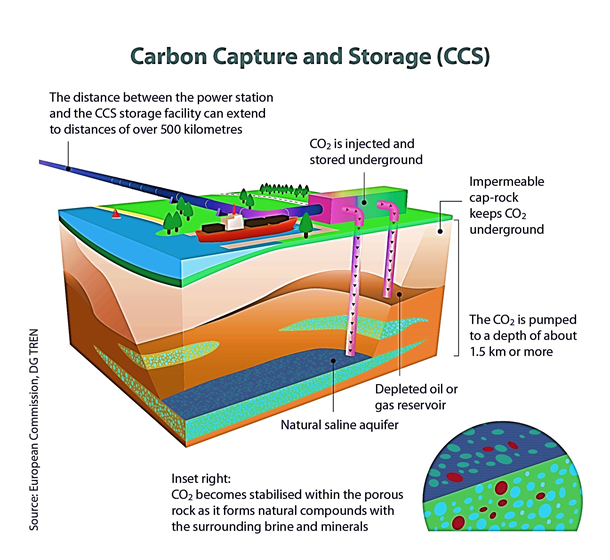- Home
- Current Affairs
- Current News
- Carbon Capture and Storage
Carbon Capture and Storage
- 05 Jan 2022
It involves the capture of carbon dioxide (CO2) emissions from industrial processes, such as steel and cement production, or from the burning of fossil fuels in power generation

3 Step Process
- Capture: The CO2 is separated from other gases produced in industrial processes, such as those at coal and natural-gas-fired power generation plants or steel or cement factories.
- Transport: The CO2 is then compressed and transported via pipelines, road transport or ships to a site for storage.
- Storage: finally, the CO2 is injected into rock formations deep underground for permanent storage.
Does it help in reducing global warming?
- If done on the scale required, it would definitely help reduce global warming.
- In 2019 (the pre-pandemic year), the world emitted 36.7 billion tons of carbon dioxide.
- Today, CCS projects are negligible in comparison with the emissions.
Where are carbon emissions stored in CCS?
- Possible storage sites for carbon emissions include saline aquifers or depleted oil and gas reservoirs.
- These typically need to be 1km or more under the ground. As an example, a storage site for the proposed Zero Carbon Humber project in the UK is a saline aquifer named ‘Endurance’, which is located in the southern North Sea, around 90km offshore.
- Endurance is approximately 1.6km below the seabed and has the potential to store very large amounts of CO2.
State In News
State In News
State In News
- Andhra Pradesh
- Arunachal Pradesh
- Assam
- Bihar
- Chhattisgarh
- Delhi
- Goa
- Gujarat
- Haryana
- Himachal Pradesh
- Jammu And Kashmir
- Jharkhand
- Karnataka
- Kerala
- Ladakh
- Madhya Pradesh
- Maharashtra
- Manipur
- Meghalaya
- Mizoram
- Nagaland
- Odisha
- Punjab
- Rajasthan
- Tamil Nadu
- Telangana
- Tripura
- Uttar Pradesh
- Uttarakhand
- West Bengal




